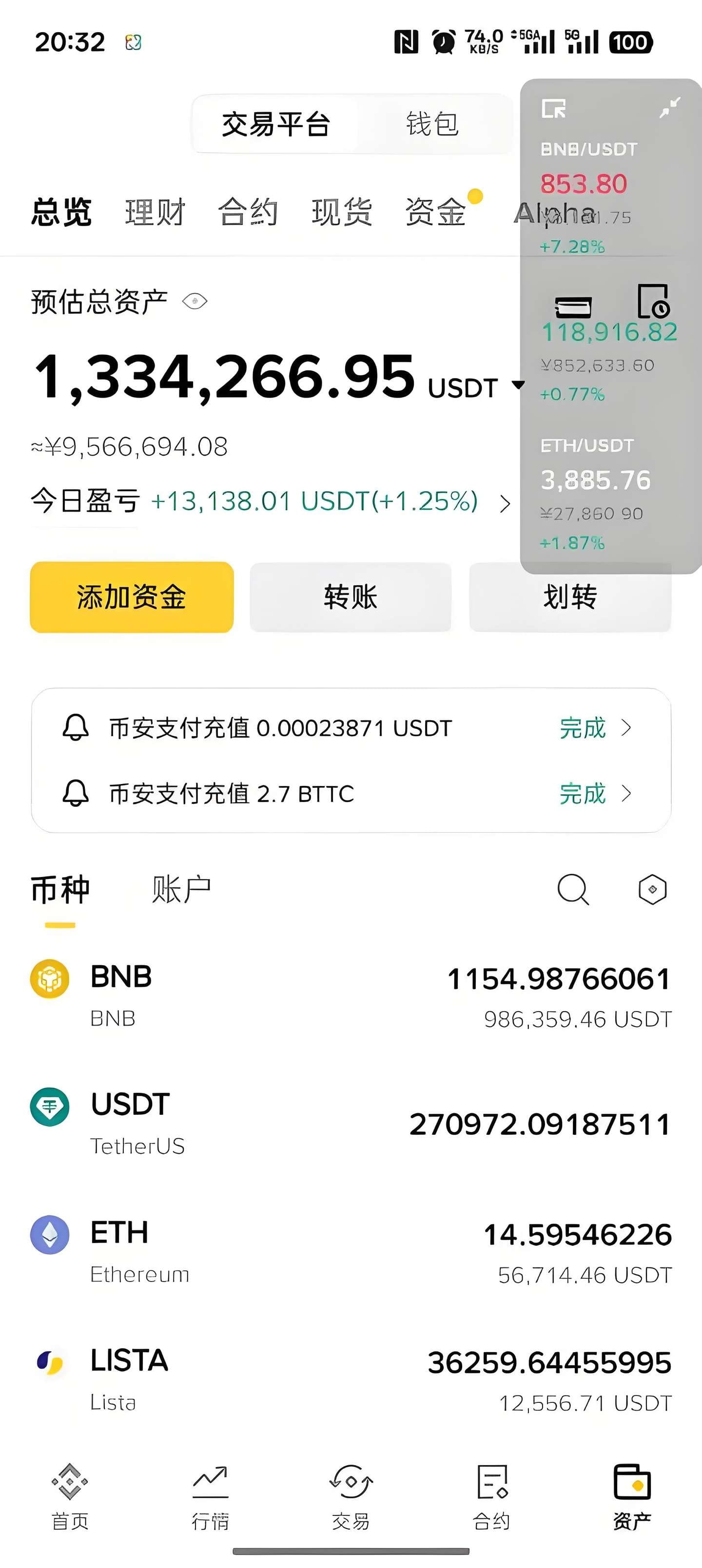From losing 800,000, then climbing back little by little with 2000 USDT! Now trading crypto supports my family, with over 34 million in the account!
In that bear market year, I lost a total of 800,000. I held on during the day but completely collapsed at night. I cleared my social media, my contacts went silent, no one understood, just me spinning in place.
During that time, I really wanted to give up, feeling the crypto world was too far from me.
Until one night, I stumbled upon a saying: 'Losses are just the beginning; messing around is the end.'
At that moment, I felt like I was awakened.
I take my last 2000 USDT as my final chip, not to gamble, but to completely start over.
I started to review each trade step by step, summarizing each one, and only then did I realize: losing money isn't about bad luck, but about not actually 'trading'.
No stop-loss, heavily over-leveraged, chasing gains and cutting losses, frequently switching coins, operating based on emotions!
To put it bluntly, I'm not strategizing, I'm just guessing sizes.
This time, I'm only doing two things: maintaining rhythm and strict execution.

The core logic of flipping accounts: when others lose and leave, why can I make 300 times?
People often ask me:
'Teacher, I've almost lost everything in the crypto world, can I really turn it around?'
I have only one answer: yes! And it definitely can!
This isn't bragging; it's the practical result of watching the market and calculating positions daily.
Why do most people end up losing money as soon as they enter the crypto world?
Going all-in right away, and getting liquidated at the slightest tremor;
When the price rises, I always feel it can go higher, holding on tightly.
Falling and fearing to cut losses at the bottom, stubbornly holding on until deeply trapped;
Clearly seeing the right direction but not daring to add positions to increase profits;
Dreaming every day of becoming rich overnight, only to exhaust the principal -
To put it bluntly, the market hasn't even started, yet my mindset has already cut myself down!
✅ My four rules for flipping the account:
1️⃣ Small position trial and error: always use only 20% to build a base; if wrong, stop-loss; this loss is completely manageable.
Endure without affecting subsequent actions;
2️⃣ Trend addition: after confirming direction, decisively increase to 70% of the position; only by daring to heavily invest can you capture the big swings.
3️⃣ Profit rolling: keep the principal intact, only use the profits made for speculation; even if you lose, your foundation remains secure.
4️⃣ Decisively take profit: the moment a top signal appears, clear out your positions, never be greedy for the last cent.
Relying on this set of 'emotionless dead rules', I've gradually increased my small funds.
Let me give two examples from around me;
There’s a fan whose account only had 900 USDT. Following this logic, within a month, it grew to 4500 USDT;
There's an older sister taking care of kids at home, following the rhythm to trade, making a steady profit of about 100 USDT daily, covering the monthly grocery expenses entirely with this operation.
They can succeed, not because of extraordinary talent, but for one reason: they don’t mess around, they faithfully execute this logic.
What kind of 'gods' exist in the crypto world? Those who can make money only achieve three things:
✅ Position management without stubbornness.
✅ Control the rhythm without panic.
✅ Execute without hesitation.
Don't be that naive grass thinking 'lying down and getting rich'.
True turning points begin with maintaining discipline and thoroughly understanding the logic!
A must-read guide for entering the crypto world|Avoid 90% of the pitfalls.
Want to play in the crypto world? First, understand these 'unwritten rules', don’t become the grass waiting to be cut -
1. Trading time ≠ rest time, focus on the golden period.
The most volatile window: Beijing time 21:30 - the next day 7:30 (when European and American traders are active), major market movements (big rises/drops) often happen at midnight.
White + night arbitrage logic:
✔️ Don't panic sell during a daytime drop; it's a good time to buy the dip (the European and American markets are likely to pump).
✖️ Don’t chase during a daytime surge; you might be dumped at night.
2. 'Spike' is a signal; understanding it can lead to big profits.
Quickly probing the bottom / rising then rebounding = 'spike', this is the trend reversal point:
▪️ Deep spike down (price plummets and then rebounds) → strong buy signal, expect a rebound.
▪️ Deep spike upwards (price surges then falls back) → strong sell signal, expect a drop.
3. The news aspect is a 'script'; don't be the honest person.
The tactics of good and bad news:
Before major positive news is announced, there’s often a wave of price rise; once the news drops, it becomes 'good news out, bad news in', and the market is dumped.
Looking at community popularity in reverse:
✔️ The coins being hyped in the group → the operator wants to harvest, going short might yield profit.
✖️ Cold coins that no one mentions in the group → could be a dark horse, try a small amount.
4. Position management = life-saving talisman, avoid these pitfalls.
Heavy positions lead to liquidation: exchanges monitor heavily-leveraged accounts for 'harvesting'; even slight volatility can lead to liquidation.
Cut losses and reverse: just after cutting losses, the market rebounds? The operator is waiting for you to 'get off' before pumping up the market.
Stuck before breaking even: when about to recover, suddenly it stops rising, forcing you to cut losses and leave (don't be fooled, hold on!).
5. Emotions are the enemy, don't be led astray.
Excitement = signal of a sharp fall: when you're happy and adding positions, the operator is preparing to dump.
FOMO trap: when the market is rising while you have no money? Intentionally tempting you to enter the market to take over, stay calm and don’t act impulsively.
6. Core thinking: 80% of the market is manipulated; you must 'take the initiative'.
Don't blindly follow trends! Wait until the operator shows a clear direction (upward/downward trend) before entering the market; it's a test of patience and determination.
Remember: surviving > short-term windfall. Following rules and controlling emotions is key to playing long-term.
The essence of the crypto world is 'a battlefield of wagering'; only those who understand the rules and can remain calm can reap rewards. Don't fantasize about 'getting rich overnight'; first learn 'not to be harvested', making money is just a byproduct ~

The key to successful investing.
Successful investing is about doing simple and correct things repeatedly. The market is like the primitive forest of Africa; the most important thing is to survive. The principle of technical analysis: keep it simple; it should be simple enough that you don’t need to think about it, and don’t blindly believe in complex technical analysis methods.
Have faith in the system you set for yourself, not in personal emotions, biases, or wishful thinking. If you want to surpass it, improve it; the system you prepare to use must be tested over time and in practice.
You must have the patience to wait for the system to issue operational signals; once the position is established, you need the same patience to hold until the system issues a reversal signal. You must strictly adhere to the principles and operate according to the signals given by the system, only entering the market when a strong trend is displayed. If you misjudge the trend, immediately cut losses and exit; if the analysis is correct, pyramid your positions. Money is earned by 'sitting', not through frantic trading; only objectively assessing trend reversals will you close positions.
How to pass the boring time of holding long positions is also key to whether one can hold long; if necessary, you can adopt an 'ostrich policy' to avoid the intense emotions generated during the most volatile periods of major market movements.
The risks and returns contained in the price are probabilities, not absolute certainties. We can use technical tools to assess the likelihood of these probabilities, but we cannot say they will definitely occur, which is why we need to set stop-losses.
You can only trade based on your views of the market. Once a person makes predictions about things, their vanity will manifest, making it hard for them to accept anything that contradicts their forecasts during trading. However, true wealth is achieved through wise exits, as it allows traders to stop losses and roll profits.
In short, people earn money by discovering themselves, realizing their potential, and aligning with market rhythms. When a rebound or consolidation occurs, people start to hesitate, trading often becomes frantic, short-term trades begin to appear frequently, and not only is direction lost, but so is self. This self is belief, and a trading system!
This kind of confusion ultimately prevents traders from going further. As long as you trade based on signals and follow the rules, you will inadvertently find that trading is not really that difficult. Stick to one method, study it thoroughly, and control your mindset; you can succeed.
Most investors do not realize that there are only a few days each month when significant profits can be made. During the rest of the time, if you don’t fall into difficulties, you are doing your job well. Always remember to keep your account intact and wait for major market movements.
Trading is like warfare; if you have a 50% assurance, you won't fight; if you have a 70% assurance, you still won't fight; only when you are 100% sure do you strike with full force. But war situations change rapidly; where can there be 100% assurance?
Technical analysis is the behavioral discipline of traders; it is primarily not about prediction. It helps you identify trends and follow them. Act when you must, stop when you must. In a strong market, buy signals in technical indicators may be precise, while sell signals may not be; in a weak market, sell signals may be precise, while buy signals may not be.
'Following the trend' positions can yield substantial profits, so never easily 'abandon ship'; during this process, many temptations may arise, luring you to seize small fluctuations urgently against the trend. Unless you are familiar with this path and have set stop-loss points, do not enter or exit casually.
People invest based on price fluctuations, but if human emotions fluctuate faster and larger than prices, they lose the most valuable calmness, making it easy to misjudge trends and, of course, easier to repeatedly overturn their established investment plans, falling into the trap of chasing gains and cutting losses.
Secrets to success in the crypto world.
Profit means persisting with the trend positions that others have given up, seizing opportunities that others do not want, and doing what others dare not do.
Investment only has lack of persistence leading to abandonment, but no thorough failure. Trading is the same; you might initially be optimistic about a direction, but with market fluctuations, you change your original stance, originally bearish but exit and go long because the market rose a bit, ultimately delaying the downward trend and causing losses against the trend. Such examples are countless in trading; any success requires persistence.
Profound insights.
The survival rule in the crypto world is not to pursue short-term windfalls, but to build a stable profit system. The compound interest effect is like rolling a snowball; the longer it lasts, the more powerful it becomes. Only by establishing a scientific position management and risk control mechanism can assets continuously appreciate amidst market fluctuations.
In facing the ever-changing market, we need to establish a dynamic observation system: when Bitcoin breaks key resistance levels, when mainstream coins show divergence signals, when the market sentiment index enters extreme ranges, these are all important nodes worth paying attention to.
True winners in the crypto world can reap profits in bull markets and preserve strength in bear markets.
Understanding trading in crypto is a similar process, from losing seven times to breaking even twice to making a profit once; it’s all about being focused and not greedy for various profit models; steadfastly sticking to this one trading system will, over time, turn it into your ATM.

What is the '343 step-by-step position building method'? Simply put, it's: don’t guess the rise or fall, buy according to the rules!
Step 1: 30% tentative position building - first pay the 'tuition' to explore.
Choose coins only based on mainstream options (BTC, ETH, SOL, BNB, etc., definitely avoid altcoins), invest 30% of total funds first.
For example, I have 200,000, and I first spend 60,000 to buy BTC. This step is not about how much to earn, it's 'testing the waters' - to understand this coin's volatility patterns, also to give myself some assurance; never go all-in at once (I fell for this before and couldn't sleep every night).
Step 2: 40% lower the cost - the more it falls, the more you buy to dilute the risk.
After buying, regardless of price movement, follow the plan to average down:
If the price rises: don’t rush to chase, wait for a pullback to key support (like the 20-day moving average), then add a bit;
If it drops: for every 10% drop, take 10% from this 40% to average down. For example, from 200,000 with 80,000, if it drops 10%, average down 20,000, drop another 10% and average down 20,000 until the 80,000 is completely averaged down.
The core of this step is 'not panicking'. Instead, be happy when it drops - the cost gets lower and lower. For example, initially buying at 60,000 when it’s at 30,000, if it drops 10%, average down 20,000 (to 27,000), drop another 10%, average down 20,000 (to 24,300)... Eventually, the average cost could drop to 26,000, and once it rebounds to 30,000, you start to profit.
Step 3: 30% trend addition - wait for signals to act.
After stabilizing 70% of the position, focus on the 'trend': when the price stabilizes at a key position (like the 7-day moving average tilting upwards or breaking through previous highs), add the remaining 30% (60,000 out of 200,000) all at once.
At this point, the trend has become clear, equivalent to 'chasing after victory'. But remember, after adding to your position, immediately set a 'trailing stop-loss' - for example, calculate from the cost price upwards, sell 20% when it rises 20%, sell 30% when it rises 50%, never be greedy waiting for the 'peak'.
Why can this simple method work? I’ve figured it out; it boils down to three points:
Do not struggle against human nature: no need to guess rises and falls (I used to guess every day; if I guessed right once, I'd brag for three days; if wrong, I'd lose for half a year), buy according to the plan, reducing entanglement and impulse to chase gains and cut losses.
Don't panic when it drops, have a bottom when it rises: buy in batches; even if it drops 30%, the position will only increase by half, unlike going all-in which could trap you; wait for the trend to come before adding positions, equivalent to 'letting profits fly for a while'.
Focus only on mainstream coins, risk is controllable: altcoins fluctuate too wildly, not suitable for this slow-paced method. Mainstream coins have consensus and liquidity; if they drop, they can recover; only buy in batches when you can hold.
For these past few years, I've been sticking to this trick, rotating BTC, ETH, SOL, and BNB, always steady like an old dog. No more staying up late watching the market; I now spend 10 minutes a day checking prices, averaging down if needed, or just taking a walk with my family.
I’m not bragging; those who study 'advanced techniques' in the crypto world are mostly just paying transaction fees to the exchanges. Instead, this 'simple method' - not being clever, following the rules - can allow you to persevere through volatility and reap rewards.
If you are also confused by technical indicators, try this trick. It may be simple, but when it comes to making money, results speak.
Ultimately, the paths that can truly go far in the crypto world are often not complex.
Those indicators adjusted at midnight are not as real as my daughter's words: 'Blocks must be stacked one by one'; those clever thoughts of always wanting to buy at the bottom and sell at the top cannot match the '343' rule hidden within - do not be greedy, do not panic, do not wait, follow the rhythm, let the money follow the rules rather than emotions.
Now, I just glance at the market while walking daily, calm regardless of rising or falling. After all, the meaning of making money has never been about staying up late staring at K-lines, but being able to smile while accompanying family to pick vegetables, listening to my daughter count the zeros in the account, turning panic into stability.
If you are also wandering in the technical maze, try this simple method. Sometimes, moving slower and being more rule-abiding can lead to going further and more steadily.


